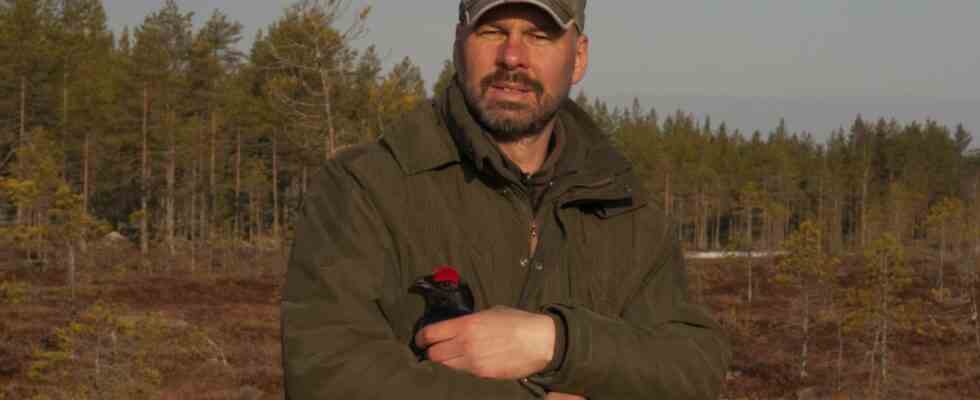“A car full of chickens.” Torsten Kirchner is happy to be back in the Rhön from Sweden. “We were very successful,” says the biologist and area manager of the high plateau called Lange Rhön. Kirchner and his team of almost ten captured ten black grouse and 14 black hens in the spring in the Swedish wilderness, about 2000 kilometers away. In the Rhön, a low mountain range between Bavaria, Hesse and Thuringia, the animals are now supposed to mate with the native specimens. Because in the biosphere reserve, the stock has been in bad shape for decades. The capercaillie, for example, or the lapwing have already disappeared.
“The black grouse is a very attractive and showy species,” says Kirchner. The cocks in particular have a characteristic appearance: the two red courtship roses on the head and the crooked plumage on the rump are eye-catchers. Black grouse are about the same size as domestic chickens and weigh around 1.2 kilograms. The hens wear brownish plumage, the cocks are dark.
Black grouse belong to the grouse family. According to the 49-year-old, the fact that their numbers in the Rhön have been shrinking since the late 1970s is alarming – and also for many other animals and plants on the approximately 3,000-hectare open high plateau. “The black grouse is the flagship, a very delicate species.” The birds need a “very large, intact habitat. And if something changes negatively, then the black grouse is an animal that reacts first. It is the touchstone of the quality of the area,” explains Kirchner. “If it starts to crumble on a large scale, we’ll see it in the other species in no time.”
Man is omnipresent – a disadvantage for the animals
Whether birds such as gray shrike, snipe or whinchat, but also many insects: The Bavarian Wildlife Foundation of the Bavarian Hunting Association, which employs Kirchner, is more than concerned about the animals in the approximately 3,300 hectare nature reserve in the reserve. Their habitat is getting smaller and smaller, there are more and more predators, and humans are omnipresent. According to the Rhön GmbH-Gesellschaft für Tourismus und Markenmanagement, more than 900,000 people arrived in the Rhön last year. “Before the corona pandemic, more than 1.6 million arrivals were recorded in 2018 and 2019,” says the current report for the years 2018 to 2021.
According to Jörg Müller, Professor of Animal Ecology at the Chair of Zoology III at the University of Würzburg, species conservation is often a difficult undertaking. “Sometimes it works, sometimes it doesn’t.” Globally, the black grouse is not threatened. “So there is no need for black grouse to be in the Rhön.” However, nature conservation is mostly about preserving biodiversity on site and for the people on site. “It is a legitimate thing to maintain a more livable environment,” says Müller. Some fought for the trees in their neighborhood, others for the hamster on building land. According to Müller, it is uncertain whether the work for the black grouse in the Rhön will be successful, since the habitat area that is still suitable today is very limited.
Showing off: Two black cocks fight for the attention of a black hen on a courtship display.
(Photo: Torsten Kirchner/dpa)
Biologist Kirchner therefore asks tourists to respect the animals’ habitat, especially at night, and not to disturb it. “The human being as a human being, who rides a bike, hikes, skis – he is simply always present.” The corona pandemic only made things worse. “Now there are tents in the landscape, the grill is brought along, even the stereo system was unpacked in Corona times. The Ballermann was moved to the Hochrhön.”
Feathered catch: Torsten Kirchner is holding a black grouse in the picture – one of a total of 24 black grouse that the biologist and his team caught in Sweden in the spring and then transported to the Rhön.
(Photo: Thomas Kuhn/dpa)
From his point of view, there should be a ban on overnight stays in the parking lots for at least hours of rest in the reserve. Kirchner would also forbid snowshoeing. “Snowshoes are made to step on the virgin snow. You don’t want to walk on a prepared slope.” And so many tourists are off the marked paths – in view of the sheer mass a catastrophe for the animals, which have to economize on their energy.
“I think it’s nonsense to basically shut people out,” says the father of two children, but it’s important to explain the consequences of dogs running free. The taxpayers paid for the preservation of the nature reserve. “And then you really have to give people the opportunity to enjoy it.” After all, the Lange Rhön is the largest nature reserve in Bavaria outside the Alps. “It’s not just about the few chickens that we absolutely want to keep here.”

